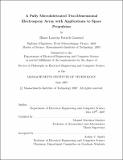A fully microfabricated two-dimensional electrospray array with applications to space propulsion
Author(s)
Gassend, Blaise L. P. (Blaise Laurent Patrick), 1978-
DownloadFull printable version (9.417Mb)
Alternative title
Fully microfabricated 2D electrospray array with applications to space propulsion
Other Contributors
Massachusetts Institute of Technology. Dept. of Electrical Engineering and Computer Science.
Advisor
Manuel Martínez-Sánchez.
Terms of use
Metadata
Show full item recordAbstract
This thesis presents the design, fabrication and testing of a fully-integrated planar electrospray thruster array, which could lead to more efficient and precise thrusters for space propulsion applications. The same techniques could be used for making arrays to increase throughput in many other electrospray applications. Electrospray thrusters work by electrostatically extracting and accelerating ions or charged droplets from a liquid surface to produce thrust. Emission occurs from sharp emitter tips, which enhance the electric field and constrain the emission location. The electrospray process limits the thrust from a single tip, so that achieving millinewton thrust levels requires an array with tens of thousands of emitters. Silicon batch microfabrication has been used, as it is well suited for making large arrays of emitters. The thruster is made using Deep Reactive Ion Etching (DRIE) and wafer bonding techniques, in a six mask process, and comprises two components. The emitter die with up to 502 emitters in a 113 mm2 area, is formed using DRIE and SF6 etching, and is plasma treated to transport liquid to the tips in a porous black-silicon surface layer. The extractor die incorporates the extractor electrode, a Pyrex layer for insulation, and springs which are used to reversibly assemble the emitter die. This versatile assembly method, with 10 µm RMS alignment accuracy and 1.3 µm RMSD repeatability, allows the extractor die to be reused with multiple emitter dies, and potentially with different emitter concepts than the one presented. The thruster, weighing 5 g, was tested with the ionic liquids EMI-BF4 and EMIIm. Time of flight measurements show that the thruster operates in the ion emission regime most efficient for propulsion, with a specific impulse around 3000 s at a 1 kV extractor voltage. Emission starts as low as 500 V. Currents of 370 nA per emitter have been recorded at 1500 V, for an estimated thrust of 26 nN per emitter or 13 µN total, and a 275 mW power consumption. The thrust efficiency is estimated around 85%. In good operating conditions, the current intercepted on the extractor electrode is well below 1%, increasing to a few percent at the highest current levels. The beam divergence half width half maximum is between 10 and 15°.
Description
Thesis (Ph. D.)--Massachusetts Institute of Technology, Dept. of Electrical Engineering and Computer Science, 2007. This electronic version was submitted by the student author. The certified thesis is available in the Institute Archives and Special Collections. Includes bibliographical references (p. 257-269).
Date issued
2007Department
Massachusetts Institute of Technology. Department of Electrical Engineering and Computer SciencePublisher
Massachusetts Institute of Technology
Keywords
Electrical Engineering and Computer Science.